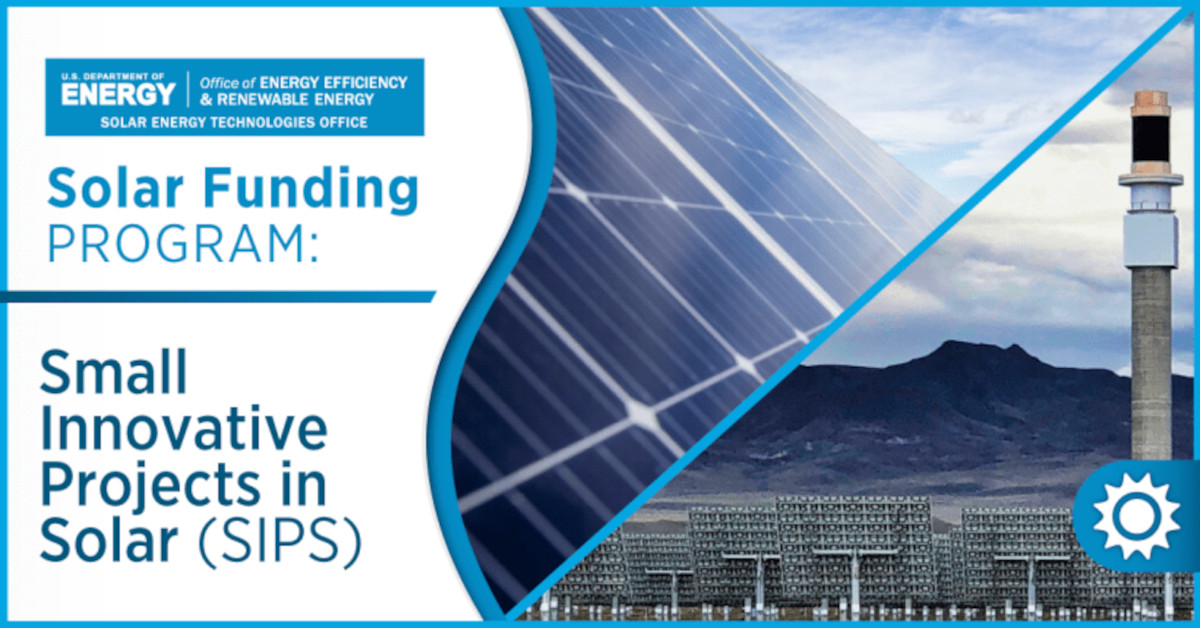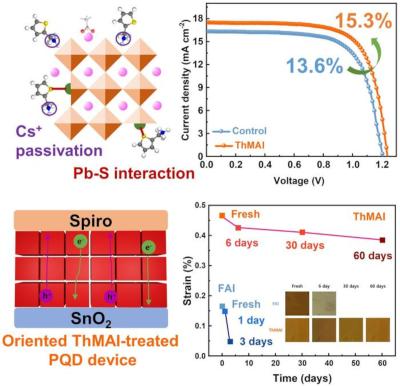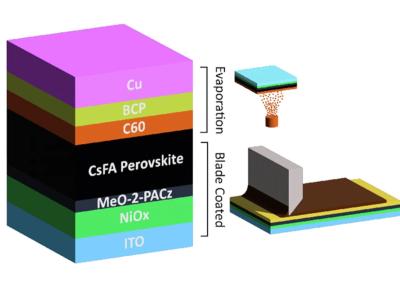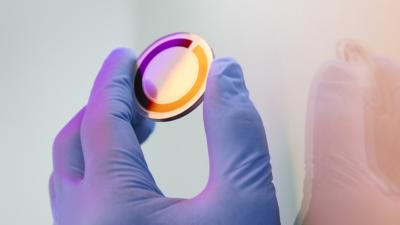Perovskite Solar - Page 6
Passivators based on lead carbanion yield inverted PSCs with 25.16% efficiency
Researchers from NingboTech University, Hunan Institute of Engineering, Hangna Nanofabrication Equipment Co. and University Malaysia Sabah have developed an inverted perovskite solar cell with an interface passivator based on lead carbanion (Pb–C–), that reportedly achieved the highest open-circuit voltage ever recorded for an inverted perovskite PV device. The lead carbanion layer was responsible for reducing defects at the interface between the perovskite layer and the electron transport layer.
Inverted perovskite cells, or “p-i-n” cells, have the hole-selective contact p at the bottom of intrinsic perovskite layer i with electron transport layer n at the top. Conventional halide perovskite cells have the same structure but reversed – a “n-i-p” layout. In a n-i-p architecture, the solar cell is illuminated through the electron-transport layer (ETL) side; in the p-i-n structure, it is illuminated through the hole‐transport layer (HTL) surface. Inverted perovskite solar cells are known for their impressive stability but have been held back by relatively low efficiencies. This issue mainly arises at the point where the perovskite layer meets the electron transport layer, causing energy loss instead of being converted into useful power, primarily caused by carrier recombination, especially at the interface between perovskite and the electron transport layer.
Researchers develop a novel strategy for increasing the efficiency of PSCs using FTO transparent conducting layers modified by atmospheric pressure plasma treatment on glass substrates
Researchers from Chungnam National University and Russian Academy of Sciences have reported a method to increase the efficiency of perovskite solar cells (PSCs) by modifying the surface of a fluorine-doped indium tin oxide (FTO) substrate using an atmospheric pressure plasma treatment.
The surface modification of the FTO film involved several challenges, such as control of the blocking layer uniformity, removal of pinholes, and deposition of a dense layer. This strategy allows the suppression of charge recombination at the interface between the FTO substrate and hole conductor.
DOE names recipients of SETO grants for R&D projects that focus on innovative ideas in photovoltaics
The U.S. Department of Energy (DOE) Solar Energy Technologies Office (SETO) Small Innovative Projects in Solar (SIPS) 2024 funding program provides $5.4 million for seedling R&D projects that focus on innovative and novel ideas in photovoltaics (PV) and concentrating solar-thermal power (CSP) and are riskier than research ideas based on established technologies.

The 16 selected projects were recently announced, among them were 5 perovskite-related projects.
New ligand exchange process enables improved perovskite quantum dots for efficient and stable solar cells
Researchers from Korea's Daegu Gyeongbuk Institute of Science and Technology (DGIST), Gyeongsang National University (GNU) and Kookmin University have developed a method to improve both the performance and the stability of solar cells using perovskite quantum dots. They developed longer-lasting solar cells by addressing the issue of distortions on the surface of quantum dots, which deteriorate the performance of solar cells.
A schematic diagram of bilateral ligand bonding on the surface of perovskite quantum dots. Image credit: Chemical Engineering Journal
Perovskite quantum dots can have excellent light-to-electricity conversion capabilities and are easy to mass-produce. However, according to the research team, in order to utilize them in solar cells, the ligands attached to the quantum dot surface must be replaced. This process often leads to distortions of the quantum dot surface, resembling crumpled paper, which results in decreased performance and shorter lifespans for the solar cells. To address this issue, the team adopted short ligands that securely hold the quantum dots from both sides, effectively uncrumpling the distorted surface. The ligands help restore the distorted lattice structure, smoothing the crumpled surface of the quantum dots. This significantly reduces surface defects, enabling the solar cells to operate more efficiently and extending their lifespan. Consequently, the power conversion efficiency of the solar cells increased from 13.6% to 15.3%, demonstrating stability by maintaining 83% of their performance for 15 days.
Researchers enable efficient and stable perovskite solar cells via in situ energetics modulation
In contrast to conventional (n–i–p) PSCs, inverted (p–i–n) PSCs offer enhanced stability and integrability with tandem solar cell architectures, which have garnered increasing interest. However, p–i–n cells tend to suffer from energy level misalignment with transport layers, imbalanced transport of photo-generated electrons and holes, and significant defects with the perovskite films.
Recently, researchers from King Abdullah University of Science and Technology (KAUST), Newcastle University, National Renewable Energy Laboratory (NREL) and Saudi Aramco Research and Development Center developed a nonionic n-type molecule (tris(2,4,6-trimethyl-3-(pyridin-3-yl)phenyl)borane (3TPYMB) that, through hydrogen bonding and Lewis acid–base reactions with perovskite surfaces or grain boundaries, enables in situ modulation of perovskite energetics, effectively mitigating the key challenges of p–i–n perovskite solar cells (PSCs).
RIT to lead $9.9 million U.S. Space Force research project
The Rochester Institute of Technology (RIT) has been selected to lead the United States Space Force University Consortium/Space Strategic Technology Institute 3 (SSTI) research regarding advanced space power and propulsion, which is backed by $9.9 million in funding.
The research is in partnership with the Air Force Research Laboratory and will enable game-changing space power and propulsion technology that will transition to the U.S. Department of Defense. The University of Michigan is also a lead institution for this research, which will include advancements in solar technology, thruster technology, and novel power approaches. As a center leader for the SSTI, RIT will work with other university partners to develop lower-cost, sustainable solar cells that can be used for power systems.
Researchers detect and eliminate performance loss caused during the transition from perovskite films to solar cells
Researchers from China's Peking University, Chinese Academy of Sciences (CAS) and Southern University of Science and Technology (SUSTech) have found that the preparation of metal electrodes by high-vacuum thermal evaporation, an unavoidable step in almost all device fabrication processes, often damages the surface of perovskite films, resulting in component escape, defect density rebound, carrier extraction barrier, and film stability deterioration. Therefore, the prepared perovskite film and the final film actually working in devices are not exactly the same, and the contribution of film optimization to the device improvement is weakened.
The team designed a bilayer structure composed of graphene oxide and graphite flakes to eliminate the unwanted film inconsistencies and thus save the film optimization loss. The team proceeded to design efficient perovskite solar cells (PSCs) with a power conversion efficiency of 25.55%, which demonstrated negligible photovoltaic performance loss after operating for 2000 hours.
Researchers optimize a blade coating process to achieve 12.6%-efficient nickel oxide-based large-area perovskite solar modules
Researchers from CHOSE (Centre for Hybrid and Organic Solar Energy) at Tor Vergata University of Rome, CNR-ISM and Saule Technologies have introduced an optimized blade coating process for the scalable fabrication of large-area (15 cm × 15 cm) perovskite solar modules with a nickel oxide hole transport layer, performed in ambient air and utilizing a non-toxic solvent system.
The research group fabricated a 110 cm² perovskite solar module with an inverted configuration and a hole transport layer that uses nickel oxide instead of commonly utilized poly(triarylamine) (PTAA). The proposed architecture aims to achieve high efficiency that is competitive with PTAA-based panels while improving stability.
Researchers introduce a new lead-halide-based Ruddlesden–Popper perovskite structure
Researchers from EPFL, University of Bern and HZB have introduced a new lead-halide-based Ruddlesden–Popper perovskite structure based on a visible-light-absorbing naphthalene-iminoimide cation. The team stated that the optoelectronic properties of this new material represent an important step toward enhancing light harvesting and affording the spatial separation of charge carrier transport in stable layered perovskite-based devices.
Incorporating organic semiconductor building blocks as spacer cations into layered hybrid perovskites provides an opportunity to develop new materials with novel optoelectronic properties, including nanoheterojunctions that afford spatial separation of electron and hole transport. However, identifying organics with suitable structure and electronic energy levels to selectively absorb visible light has been a challenge in the field. In their recent paper, the team introduced a new lead-halide-based Ruddlesden–Popper perovskite structure based on a visible-light-absorbing naphthalene-iminoimide cation (NDI-DAE).
Perovskia updates on recent activities
Empa spin-off Perovskia has launched perovskite solar cells that can be used in smartwatches, keyboards etc. Perovskia Solar has specialized in custom-made solar cells for electronic devices, and has recently acquired more than ten companies from the Internet of Things (IoT) industry as new customers and received over two million Swiss francs from an international coalition of business angels and early-stage funds.
“Energy harvesting for IoT devices is a rapidly growing market with a potential of several billion dollars,” said Anand Verma, founder and Chief Executive Officer (CEO) of Perovskia. “Our easy-to-integrate designer solar cells either eliminate the need for batteries or extend their lifespan, opening up the possibility of powering any device with solar energy.”
Pagination
- Previous page
- Page 6
- Next page







